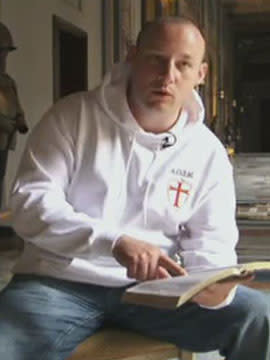 The Lookout
The LookoutHow did the medieval Knights Templar influence Norway gunman?

In his 1,500-page manifesto, confessed Norwegian mass killer Anders Behring Breivik claimed allegiance to a resurrected version of the Knights Templar, a medieval formation of Christian soldiers who waged brutal battle against Islam for control of the Holy Land and its relics. Breivik also wrote favorably of the mentorship of a British man known as "Richard (the Lionhearted)," who he credits for imparting to him the secrets of the Templar tradition.
In an exclusive report, AP correspondent Simon Haydon writes that he has located "Richard," whose actual name is Paul Ray, living in exile in Malta. In an interview with Haydon, Ray confirmed that he is associated with "a loose group of anti-Islamic extremists inspired by the Knights Templar," but denied that Breivik was associated with the group, or that he had served as Breivik's mentor.
"My thoughts are the same ... that there is a threat to our way of life from Islam. I'm not going to say I don't think there is, because I do," Ray told Haydon. Ray writes an anti-Muslim blog called "Lionheart" after King Richard I of England, who lead 12th-century Christian crusades.
Ray told the AP that he has embraced the Templar tradition in an effort to drive home the threat of Muslim immigration. "Muslims in (England) trying to take over our country. Let's not pretend it's not happening. They are actively declaring their vision to take our country over." He told the AP he did not approve of Breivik's methods, however.
That's not to say that the original Knights were at all peace-loving; quite the contrary. As Time writer Ishaan Tharoor notes, the Knights Templar formed at the site of the al-Aqsa mosque in Jerusalem, which fell into Christian control after the first crusade of 1099, and were known as ruthless warriors. And while the Knights tried to cultivate an image as ascetic spiritual pilgrims, they extorted enormous gold and precious-metal tributes from Jewish and Muslim subjects in the Middle East, as well as among the unfortunate Christian populations in Europe who came into their path.
That history, indeed, accounts for the order's best known pop culture legacies, Dashiell Hammett to Dan Brown. After the Templars were dissolved in 1312, a later religious order based on the island of Malta (where now makes Ray's home in solidarity with the order's aims) continued hoarding gold and precious stones--and thereby furnished the inspiration for the bloody intrigue in Hammett's hardboiled suspense novel, "The Maltese Falcon," and the classic John Huston film of the same name. The order has continued to claim a prominent place in modern-day fables of shadowy conspiracy. As legions of "Da Vinci Code" readers well know, the group is a favorite hobbyhorse of pulp-antiquarian novelist Dan Brown.
Nor is the order's latter-day appeal confined to fiction writers and fringe anti-immigrant figures in Europe. As hard-core advocates of white ethnic purity, Breivik and Ray would no doubt be baffled to learn that a new Mexican drug cartel calls itself the Knights Templar. According to a report in Al Jazeera, this latest twist on the Templar legend was the brainchild of a schoolteacher named Servando Gomez, who has members dress up in full medieval Templar regalia, and swear out loyalty oaths in blood. While the group professes to devote itself to philanthropic works--including drug rehabilitation centers in Gomez's home province of Michoacan--it is an offshoot of La Familia, the second most powerful and lethally violent drug cartel in Mexico. In other words, while the historic Knights of Templar are long gone, claimants to its legacy are continuing to honor, consciously or otherwise, its tangled legacy of blood, piety, and treasure.
Other popular Yahoo! News stories:
• Teacher suspended for blog rant returns to the classroom
• Rick Perry downplays default fears, calls debate 'political theater'
• Iraq vet accused of faking portions of best-selling memoir
